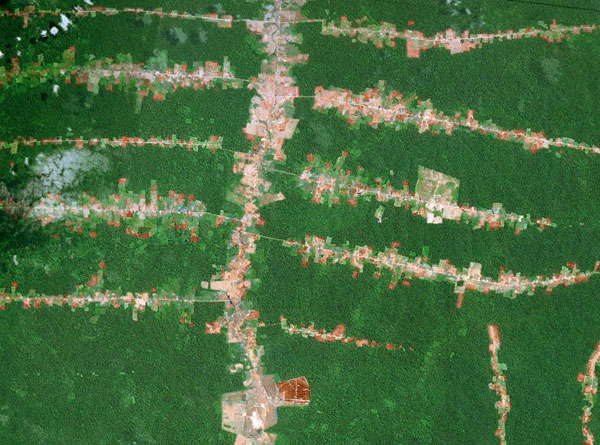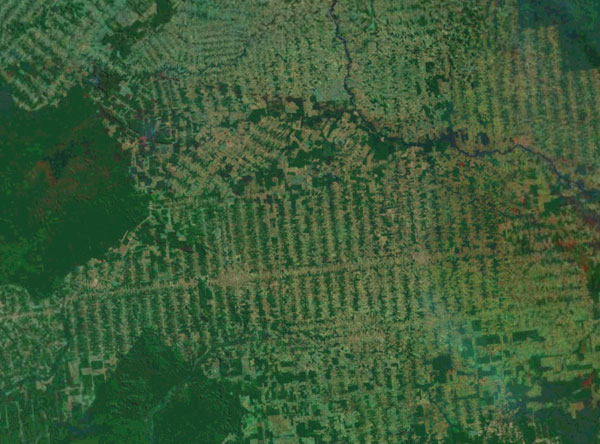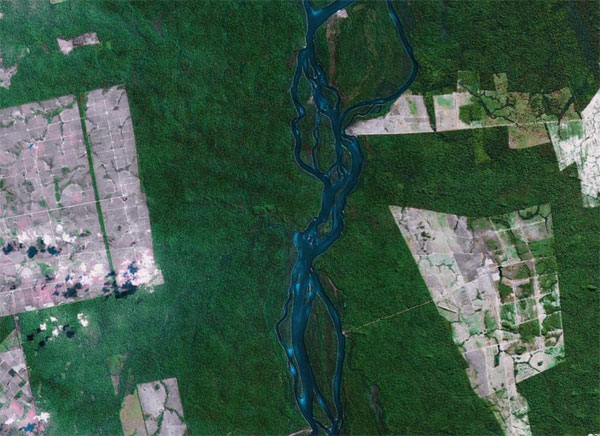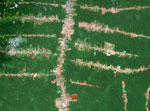
Roads in the Brazilian Amazon. Courtesy of Google Earth.
94.9 percent of deforestation in the Brazilian Amazon occurs on land less than 5 kilometers from a road or navigable river, finds a new study published in the journal Biological Conservation.
The paper, which involved researchers from South Dakota State University, Imazon, and James Cook University, is based on analysis of satellite images and data from the Brazilian government. It finds that the rapidly expanding network of official and unofficial roads in the Brazilian Amazon are a key enabler of deforestation by opening up previously inaccessible areas to speculators, miners, loggers, ranchers, and farmers.
The results are consistent with a large body of research showing higher rates of deforestation, fire, and hunting impacts in proximity to roads. But the research goes a step further, concluding that protected areas are effective in limiting damage from increased accessibility provided by roads and major rivers.
“Proximity to transportation networks, particularly the rapidly growing unofficial road network, is a major proximate driver of deforestation in Amazonia,” the authors write. “Protected areas are having a strong mitigating
effect on that risk.”
“Protected land contained a higher percentage of remaining forest in all distance classes,” they continue. “Protected areas showed resistance to deforestation, compared to unprotected forests, even when these forests were accessible; 10.9% of protected forests have been lost, compared with 43.6% of similarly accessible unprotected forests.”

Google Earth image showing forest cleared along roads in the Brazilian Amazon.
The researchers added that less than 1.5% of all protected forest across the Brazilian Amazon were cleared between 1988 and 2006, indicating that parks and reserves remain an important component in efforts to save the world’s largest rainforest.
“All protected area types mitigated deforestation risk and had four times less deforestation than unprotected areas even when highly accessible. The continued presence of protected areas is critical in the Amazon, and is especially crucial where forests are accessible via roads or navigable rivers.”

Clearing near a river in the Brazilian Amazon. Courtesy of Google Earth.
CITATION: Christopher P. Barber, Mark A. Cochrane, Carlos M. Souza Jr, William F. Laurance. Roads, deforestation, and the mitigating effect of protected areas in the Amazon. Biological Conservation 177 (2014) 203–209.
Related articles
Roads through the rainforest: an overview of South America’s ‘arc of deforestation’

(07/21/2014) When a new road centipedes its way across a landscape, the best of intentions may be laid with the pavement. But roads, by their very nature, are indiscriminate pathways, granting access for travel and trade along with deforestation and other forms of environmental degradation. And as the impacts of roads on forest ecosystems become clear, governments and planning agencies reach a moral crossroads.
Roads could help protect the environment rather than destroy it, argues Nature paper

(03/22/2013) Rapidly expanding road networks are causing large-scale damage to forests but proper infrastructure planning and implementation could actually turn them into a net positive for the environment, argue researchers writing in the journal Nature. William Laurance and Andrew Balmford highlight the severe environmental impacts of roads in wilderness areas, including fostering illegal logging, poaching, colonization, and land speculation.
50,000 km of roads built across Brazilian Amazon in 3 years
(10/29/2013) Roads are rapidly expanding across the Brazilian Amazon opening up once remote rainforests to loggers, miners, ranchers, farmers, and land speculators, finds a new study published in the journal Regional Environmental Change.